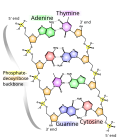Self-replication
- REDIRECT Template:See also
Replication is a general word for making a copy. Self-replication is how a thing might make a copy of itself. Biological cells, in suitable environments, reproduce by cell division. The process is self-organising, given the basic machinery of a cell. During cell division, DNA is replicated and can be transmitted to offspring during reproduction.
Other kinds of replication occur. RNA viruses use the mechanism of a cell to replicate their own RNA strand and make its protein coat. Retroviruses are one of most important RNA viruses; there are a number of other types. Viruses can only reproduce by taking over the reproductive machinery of cells through infection. Computer viruses reproduce using the hardware and software already present on computers.
Memes reproduce using the human mind and culture as their reproductive machinery.
Self-replication Media
References
- von Neumann, J., 1966, The Theory of Self-reproducing Automata, A. Burks, ed., Univ. of Illinois Press, Urbana, IL.
- Kenyon, R., Self-replicating tilings, in: Symbolic Dynamics and Applications (P. Walters, ed.) Contemporary Math. vol. 135 (1992), 239-264.
- http://www.cs.bgu.ac.il/~sipper/selfrep/ Archived 2017-03-03 at the Wayback Machine The Artificial Self-Replication Page


